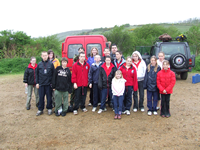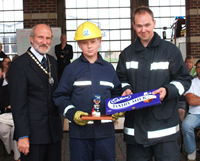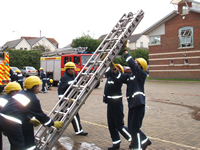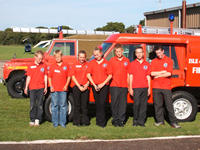Young Firefighters Association
Fire Cadet Weekend Spring Camp 6/7th May 2006
On a very wet Saturday morning, the cadets made the trip to Compton Farm to set up camp in preparation for a weekend full of camping, cooking, navigation exercises, and sports.
Youth coordinator Pauline Connelly, adult helpers/instructors Kevin Beckett, Sam Ade, Wayne Jones, Damon Corr, Sharon Corr, and Brigade Manager Paul Street organized food for the cadets despite the terrible weather.
Cadets traveled by minibus to Brighstone Forest in the afternoon to participate in a team orienteering exercise. Junior Instructor Grace Connelly led the winning squad: Fire Cadet Sophie Jones, Fire Cadet Marie Howlett, Recruit Fire Cadet Kayleigh Hunnybun, and Recruit Fire Cadet Kandi Waterman.

A squad of female cadets led by JI Eilidh Barr placed second, while the male cadets finished in last place.
If the cadets thought they were fatigued after the eight-kilometre night navigation march to the Long Stone (Mottistone) and back, they were undoubtedly exhausted after the Saturday evening after-dinner sports. Along the train, the cadets studied night navigation and improvised navigation abilities, which did not include constellations due to the cloudy sky.
Sunday morning and into the afternoon, cadets participated in Exercise “Down & Out.” This was designed to reinforce all they had learned about navigation and searching to conduct a search and rescue operation for a downed pilot (another dummy) and an aircraft’s “black box” amid dense woods in Westover and Chessell Down. Team Alpha 2 (led by Leading Fire Cadet Dominic Perkins) successfully located the black box and returned to the command post on the Tennyson Trail. Team Alpha 1 eventually and with the assistance of hastily reinforced Team Alpha 3 (composed of Team 2 cadets who were not too exhausted to continue) located the missing pilot and returned him to safety despite being thrown off course by an incorrect search start point location.
The weekend we concluded with a late lunch, packing up, and cleaning up before returning to Ryde Fire Station and heading home for a well-deserved night’s rest.
More graduates to Junior Instructor
Grace Connelly and Eilidh Barr, who turned seventeen in the spring of 2006, were invited to remain with the association as Junior Instructors and accepted the invitation. Adult instructors and helpers benefit significantly from allowing cadets who have reached the maximum age to stay in contact with the group, share their knowledge and experience, and assist with training demands.
Breathing Apparatus (BA) Training – January/February 2006
The Cadets were introduced to the skills required to safely and effectively use self-contained breathing apparatus at fire and rescue incidents by Branch Officer in Charge and Breathing Apparatus Instructor Damon Corr.
When training, the cadets detach the facemask from the air cylinder for safety reasons, but they use the BA equipment in the same way that fire departments across the country do.
The training culminated in an extensive scale building fire exercise, in which they experienced carrying out simulated firefighting and rescues while wearing BA. Fire Cadet Ryan Walker admirably completed the tasks of a BA Entry Control Officer. Leading Fire Cadets Grace Connelly and Eilidh Barr commanded both the incident and sectors, detailing BA teams to search areas of the smoke-logged building until all simulations were completed.
Annual Parade & Awards Ceremony – 11th September 2005
Attendees at the Ryde Young Firefighters Annual Parade and Awards Ceremony included the cadets’ friends, family, and community members. Councillors Charles Chapman and Barry Abraham, along with Brigade Manager Paul Street, were the ones to hand out the awards.
 Ben Hallam, a Fire Cadet, was recognized as the “Cadet of the Year” for the 2004/2005 school year. FF Sam Ade of Ryde Fire Station determines this award. It is based on the commitment shown during activities involving young firefighters, as seen by attendance, behavior, attitude, and presentation.
Ben Hallam, a Fire Cadet, was recognized as the “Cadet of the Year” for the 2004/2005 school year. FF Sam Ade of Ryde Fire Station determines this award. It is based on the commitment shown during activities involving young firefighters, as seen by attendance, behavior, attitude, and presentation.

Before concluding the practical portion of the day with a lighthearted water-transportation team competition in which all contestants received a thorough soaking, which was nice for some on a warm afternoon, the cadets put on a magnificent exhibition of elemental fire and rescue abilities and disciplines.
Several cadets got individual accomplishment certificates for finishing FIRECAP-acquired units (Fire Cadet Achievement Program). Prizes were given for both firefighting prowess and aspects of home fire safety. Leading Fire Cadets also got honors for demonstrating the necessary levels of officership in leading fire cadets during both fundamental exercises and comprehensively simulated building fire scenarios.
Leading Fire Cadet Youssef Samir-Youssef (also known as “Joe”) became the first cadet to graduate to the position of “Junior Instructor” after turning seventeen. Youssef has been an eager and dedicated cadet, a leading fire cadet, and a junior member of the instructing team from the young firefighters’ establishment in May 2003. Youssef observed the formality of turning over his cadet helmet to Councillor Charles Chapman and having it formally changed with the same conventional fire helmet worn by serving service members.
During the same ceremony, Cadets Grace Connelly and Dominic Perkins were promoted to Leading Fire Cadets.
1st September 2005

The Isle of Wight branch of the Popular Flying Association, in collaboration with the Isle of Wight Airport, Sandown, treated fire cadets to a one-day airport awareness and flying course.
The excitement of flying in a light single-engine aircraft with experienced pilots at the controls to direct them throughout the day was personally experienced by the cadets. Many had the distinction of being able to “take the controls” after they were airborne, and PFA members remarked on the cadets’ natural talent after receiving some instruction.
 After the day, the PFA gave each trainee a unique image and a certificate under the ‘Young Eagles’ program, a global project designed to introduce young people to the joys and abilities of light-aircraft piloting.
After the day, the PFA gave each trainee a unique image and a certificate under the ‘Young Eagles’ program, a global project designed to introduce young people to the joys and abilities of light-aircraft piloting.